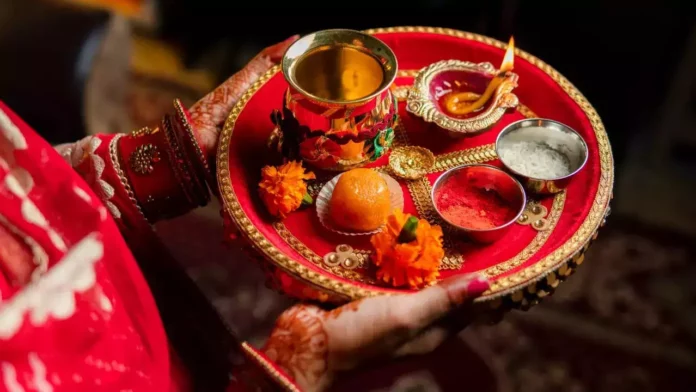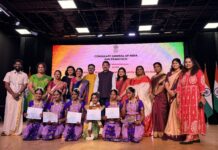Madhumati Tyagi and Geetha Patil
Why is Karva Chauth Vrat Observed?
Karva Chauth Vrat is an auspicious Sanatani festival, which is celebrated with pomp and vigor. This is a special occasion for married women, who observe fasting on this for a happy and prosperous married life and for the well-being of the husband and is one of the most popular Sanatana fasting and ritual. According to Drik Panchang, this festival is celebrated on Sunday, October 20, 2024, and is observed on the Krishna Paksha Chaturthi in the Sanatana month of Kartika.
Karva Chauth in Sanatana Scriptures
Karva Chauth is dedicated to Lord Shiva and Goddess Parvati. It is believed that Goddess Parvathi had observed severe penance to get Lord Shiva as her husband. Sanatana women follow the fasting practice observed by Goddess Parvati for her husband Lord Shiva.
What are the Karva Chauth Fasting Rules?
On the Karva Chauth day after an early morning bath, married women eat food made from selected grains and fruits before sunrise. After the sunrise, the women observe a strict fasting and some people even do not drink water.
Generally, women in the neighborhood gather in a house/temple and take advice from elderly women on how to observe Karva Chauth puja. They also listen to the significance to Karva Chauth Katha (stories) and perform rituals together. The fasting is broken after seeing the moon at night along with her husband. The moon is seen through a sieve. Later, women break the fast with an offering of water and flowers to the moon.
Karva Chauth Dos and Don’ts
- Red color dresses are the preferred on the day as it is considered auspicious for married woman. Blue, brown and black color dress should not be worn on the day. Many women dress in traditional attire, often in shades of red, maroon, or pink, which are considered auspicious. In fact, many people re-wear their wedding dresses as part of the Karva Chauth celebrations. They also adorn themselves with jewelry, bangles, and apply mehndi (henna) on their hands.
- The women performing the vrat should not distribute milk, curd, uncooked rice and white color cloth.
- One should not get angry and insult elderly people on the day.
- Goddess Parvati should be worshipped before the seeing the moon. She should also be offered Puri and Halwa as Prasad.
Karva Chauth Sargi from Mother-in-law
Especially in Punjab and Haryana, mother-in-law prepares Sargi for her daughter-in-law. Sargi is a kind of meal basket with fresh fruits, sweets, dry fruits, traditional snacks and coconuts and other regional items. As those observing the vrat do not eat food or drink water after sunrise, however, the food items in Sargi are consumed before sunrise on Karva Chauth day. Now a day, gifts like sari and jewelry are included as the part of Sargi.
 In the evening, the Karva Chauth Puja is performed with a group of women in a temple or at home with family members. The puja involves offering of prayers to Goddess Parvati and Lord Shiva. An earthen pot called Karva filled with water and covered with a lid, which represents prosperity, is used.
In the evening, the Karva Chauth Puja is performed with a group of women in a temple or at home with family members. The puja involves offering of prayers to Goddess Parvati and Lord Shiva. An earthen pot called Karva filled with water and covered with a lid, which represents prosperity, is used.
A story of Karva Chauth, known as the Karva Chauth Vrat Katha, is narrated, emphasizing the importance of faith, devotion, and the bond between husband and wife.
After this, women eagerly wait for the moon to rise. During this time, women gather with their families on terraces or open areas where the moon is visible. Traditionally, women hold a sieve or chainni in their hand as they are waiting to see the Moon.
Once, the moonrises, the ritual begins. Women view the moon through a sieve and then, look at their husbands through the same sieve, symbolizing the filtering of negative energy and receiving only the blessings for a long married life. This act is accompanied by offering of water/Arghya to the moon, which is poured through the sieve as gesture of respect and devotion.
How to break and end the fasting?
After the Moon Puja, the husband offers his wife the first sip of water and a bit of food, which marks the official breaking of the fast. Many couple then, enjoy a small meal together, often including traditional sweets and foods prepared for the occasion. The conclusion of the fasting is a joyous time, marked by families coming together to share a meal and celebrate the festival with much devotion. It is also a time for exchanging gifts and blessings between family members, especially the husband and wife.
What is the significance of Karva Chauth?
Karva Chauth is more than just a fasting. It is celebration of love, faith, and commitment between married couples. The day serves as a reminder of the enduring bond shared by husband and wife, and the length to which they are willing go by caring each other’s well-being. This tradition has a deep spiritual meaning, which has evolved into a festival that strengthens familial ties and celebrates our cultural heritage.
This Katha represents a wife’s strength and devotion to her husband. It exhibits the power of unwavering commitment, faith, and steadfast resolution in the face of adversity. The marital bond is not only emotional but also spiritual, and through such devotion, the longevity of marital life can be safeguarded. The bond between husband and wife is strengthened by performing the rituals of Karva Chauth. In addition, listening to the Vrat Katha with devotion helps gain the benevolent blessing from the holy Katha, further enhancing the benefits of the puja and a day long fasting. Karva Chauth promises a night of devotion and festivity, uniting families in the spirit of love and togetherness.







